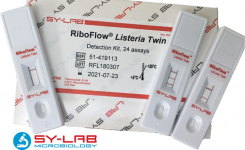Strip Based Immunoassays
Key Points
- Simple to use
- Results can be available within 15 minutes
- Low cost with no requirement for additional equipment
- Stable and robust in storage
 While rapid methods have made a major impact on microbiological testing over the last twenty years or so, only a handful of developments can claim to have taken testing out of the laboratory. One that can, and is in widespread use as a result, is the lateral flow immunoassay test, also known as the immunochromatographic assay, or strip test. Like many of the best ideas, lateral flow immunoassays take clever and sophisticated technology and turn it into something so simple to operate that almost anyone can use it.
While rapid methods have made a major impact on microbiological testing over the last twenty years or so, only a handful of developments can claim to have taken testing out of the laboratory. One that can, and is in widespread use as a result, is the lateral flow immunoassay test, also known as the immunochromatographic assay, or strip test. Like many of the best ideas, lateral flow immunoassays take clever and sophisticated technology and turn it into something so simple to operate that almost anyone can use it.
The technology The basic technology that underlies lateral flow immunoassays was first described in the 1960s, but the first commercial application was Unipath’s Clearview home pregnancy test launched in 1988. Since then, the same technology has been employed to develop a wide and ever-growing range of tests for clinical, veterinary, agricultural, food industry, bio-defence and environmental applications.
Strip tests are extremely versatile and are available for an enormous range of analytes from blood proteins to mycotoxins and from viral pathogens to bacterial toxins. An assay has even been developed for wine producers to assess the amount of Botrytis rot in newly harvested grapes.
Lateral flow immunoassays are essentially immunoassays adapted to operate along a single axis to suit the test strip format. A number of variations of the technology have been developed into commercial products, but they all operate according to the same basic principle.
How does a lateral flow immunochromatographic assay work?
A typical test strip consists of the following components:
- Sample pad – an absorbent pad onto which the test sample is applied
- Conjugate or reagent pad – this contains antibodies specific to the target analyte conjugated to coloured particles (usually colloidal gold particles, or latex microspheres)
- Reaction membrane – typically a hydrophobic nitrocellulose or cellulose acetate membrane onto which anti-target analyte antibodies are immobilised in a line across the membrane as a capture zone or test line (a control zone may also be present, containing antibodies specific for the conjugate antibodies)
- Wick or waste reservoir – a further absorbent pad designed to draw the sample across the reaction membrane by capillary action and collect it
The components of the strip are usually fixed to an inert backing material and may be presented in a simple dipstick format or within a plastic casing with a sample port and reaction window showing the capture and control zones.
There are two main types of lateral flow immunoassay used in microbiological testing:
Double antibody sandwich assays In this format the sample migrates from the sample pad through the conjugate pad where any target analyte present will bind to the conjugate. The sample then continues to migrate across the membrane until it reaches the capture zone where the target/conjugate complex will bind to the immobilised antibodies producing a visible line on the membrane. The sample then migrates further along the strip until it reaches the control zone, where excess conjugate will bind and produce a second visible line on the membrane. This control line indicates that the sample has migrated across the membrane as intended. Two clear lines on the membrane is a positive result. A single line in the control zone is a negative result. Double antibody sandwich assays are most suitable for larger analytes, such as bacterial pathogens and viruses, with multiple antigenic sites.
Competitive assays Competitive assays are primarily used for testing small molecules and differ from the double antibody sandwich format in that the conjugate pad contains antibodies that are already bound to the target analyte, or to an analogue of it. If the target analyte is present in the sample it will therefore not bind with the conjugate and will remain unlabelled. As the sample migrates along the membrane and reaches the capture zone an excess of unlabelled analyte will bind to the immobilised antibodies and block the capture of the conjugate, so that no visible line is produced. The unbound conjugate will then bind to the antibodies in the control zone producing a visible control line. A single control line on the membrane is a positive result. Two visible lines in the capture and control zones is a negative result. However, if an excess of unlabelled target analyte is not present, a weak line may be produced in the capture zone, indicating an inconclusive result. Competitive assays are most suitable for testing for small molecules, such as mycotoxins, unable to bind to more than one antibody simultaneously. There are a number of variations on lateral flow technology. The capture zone on the membrane may contain immobilised antigens or enzymes - depending on the target analyte - rather than antibodies. It is also possible to apply multiple capture zones to create a multiplex test. For example, commercial test strips able to detect both EHEC Shiga toxins ST1 and ST2 separately in the same sample have been developed.
Lateral flow immunoassays are simple to use by untrained operators and generally produce a result within 15 minutes. They are very stable and robust, have a long shelf life and do not usually require refrigeration. They are also relatively inexpensive to produce. These features make them ideal for use at the point-of-care and for testing samples in the field, as well as in the laboratory. However, their sensitivity is limited without additional concentration or culture procedures.
Quantitative tests While most lateral flow immunoassays are only capable of providing a qualitative result, it is possible to obtain some degree of quantification by measuring the amount of conjugate bound to the capture zone. This can be done using a dedicated reader to measure the intensity of the coloured test line. For example, the Neogen Corporation has developed the Accuscan™ lateral flow reader for use with its range of Reveal® assay kits and Charm Sciences also supplies a reader for its Rosa® range of mycotoxin test strips. More sophisticated techniques, such as fluorescent dye labelled conjugates, have also been developed to improve the quantitative potential of lateral flow assays. Applications In the 20 years since the first lateral flow test was launched a huge range of different tests have been developed based on the same technology. The first commercially available kits were aimed at the clinical diagnostics field, but there are now products with applications in almost every branch of microbiology.
Clinical microbiology – lateral flow tests have been developed for bacterial pathogens, respiratory and enteric viruses, intestinal parasites and bacterial toxins. Many of the lateral flow immunoassay products designed for the clinical sector are intended to be used at the point-of-care for direct testing of faecal, blood and urine samples and nose and throat swabs, where the simple operation and speed of the tests is key to their use outside of the laboratory. However, the same test strips may also be useful as a quick confirmatory test following laboratory culture of clinical samples.
Food and agricultural microbiology – test strips are available for foodborne bacterial pathogens, bacterial and fungal toxins. In the food microbiology sector, the main applications are more likely to be in the laboratory, although there are field test kits for mycotoxins in grain samples. Testing for foodborne bacterial pathogens generally involves at least one enrichment stage before the assay strip is used to confirm the presence or absence of the pathogen. Some manufacturers, such as Hygiena, have developed enrichment media and methods specifically designed for use with lateral flow test strips. Test strips may also be useful for rapid confirmation of the identity of bacterial isolates from conventional microbiological testing.
Water and environmental microbiology - limited assays available.
Get the latest updates in Rapid Microbiological Test Methods sent to your email? Subscribe to the free rapidmicrobiology eNewsletter























